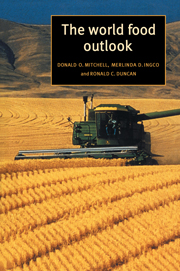Book contents
- Frontmatter
- Contents
- List of figures
- List of tables
- Preface
- List of abbreviations
- 1 The world food problem
- 2 The price of food
- 3 Gains in consumption levels
- 4 World food production increases
- 5 Population growth and food demand
- 6 The quantity and quality of the resource base
- 7 Raising yields
- 8 Changing consumption patterns
- 9 Simulating the future world food situation
- 10 The world can feed twice as many in twenty years
- 11 A robust prediction?
- 12 Africa presents a special challenge at the turn of the century
- Appendix The World Grains Model
- References
- Index
3 - Gains in consumption levels
Published online by Cambridge University Press: 06 November 2009
- Frontmatter
- Contents
- List of figures
- List of tables
- Preface
- List of abbreviations
- 1 The world food problem
- 2 The price of food
- 3 Gains in consumption levels
- 4 World food production increases
- 5 Population growth and food demand
- 6 The quantity and quality of the resource base
- 7 Raising yields
- 8 Changing consumption patterns
- 9 Simulating the future world food situation
- 10 The world can feed twice as many in twenty years
- 11 A robust prediction?
- 12 Africa presents a special challenge at the turn of the century
- Appendix The World Grains Model
- References
- Index
Summary
Another way of assessing the world food situation is to see whether or not the level of people's nutrition is improving. While not a complete measure of the level of nutrition, per capita calories consumed, or available for consumption, is a useful indicator. Per capita calorie supplies in developing economies rose by about 27 per cent from 1961 to 1989 (figure 1.2). The average level of per capita calorie supplies in developing economies has exceeded the FAO's estimated minimum daily calorie requirement since 1980. Increases in domestic food production and imports assisted these increased levels of per capita calorie consumption.
While these gains are impressive, they cannot lead us to the conclusion that the whole population has an adequate diet. Averages for all developing economies hide the distribution of calories both within and among economies. Hunger, undernutrition (arising from insufficient food) and malnutrition (arising from the wrong balance of food) are very serious problems for many people. Undernutrition caused by a dietary energy intake below the required minimum level is both obvious and of major concern in many developing economies. Undernutrition is often accompanied by inadequate levels of protein or specific nutrients. On the other hand, in industrial economies the principal dietary problem is overnutrition, or malnutrition caused by improper composition of diets (FAO 1987a).
Despite steady increases in calorie supplies in developing economies since the 1960s, an estimated 20 per cent of their population is still chronically undernourished. But this proportion is estimated to have declined from 36 per cent (941 million) to 20 per cent (786 million) from 1969 to 1990 (FAO 1993).
- Type
- Chapter
- Information
- The World Food Outlook , pp. 23 - 27Publisher: Cambridge University PressPrint publication year: 1997



